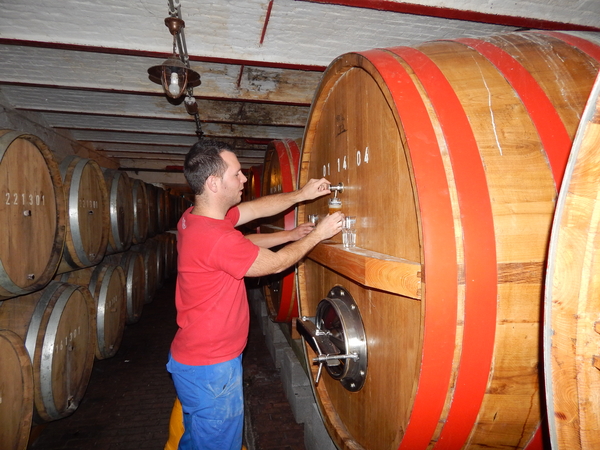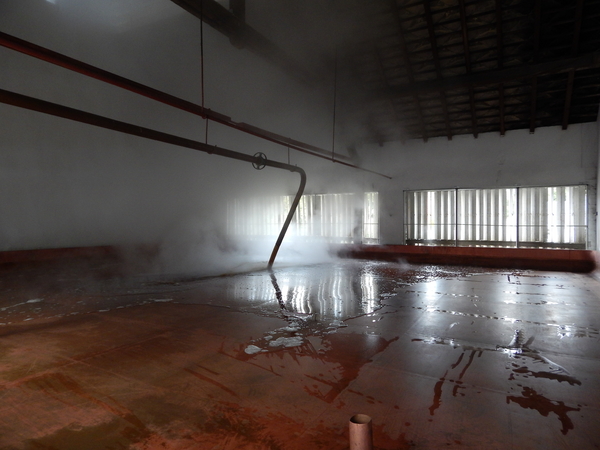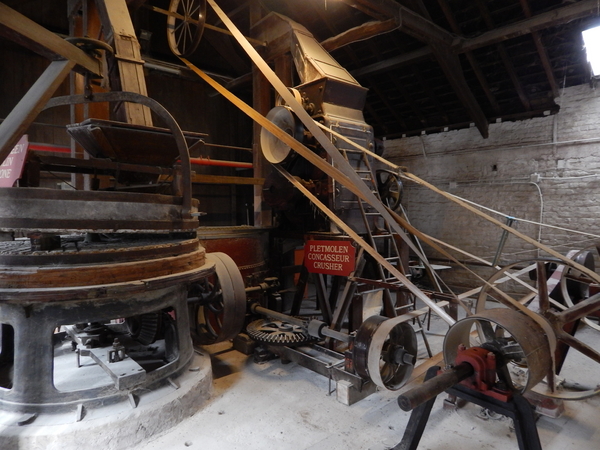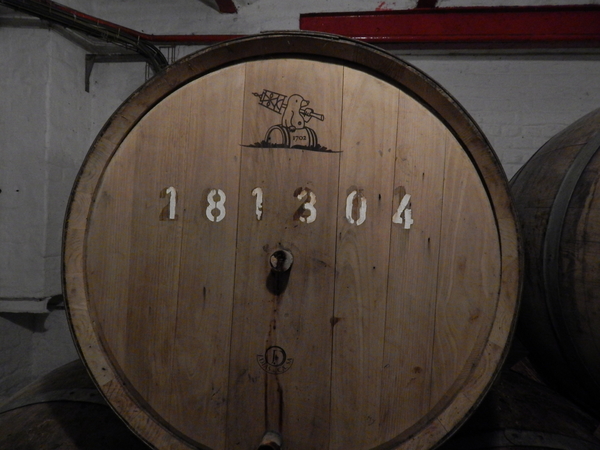Timmermans and the magical mystery tour that creates the ancient style of lambic beer
Added: Sunday, November 9th 2014

They treat lambic with great sobriety in Belgium. It’s a beer with history and prestige. Timmermans Brewery in Itterbeek, a few kilometres from Brussels, is in the district of Halle that was once packed with lambic breweries and they worked under strict guidelines from the local authority.
Willem Van Herreweghen, brewing advisor at Timmermans, shows me an ordinance from Halle town council dated 1560 that stipulates that “nobody will make a mash without 16 razieren of grain: six razieren of wheat and 10 of barley”. Razieren, Willem explains, is an old, extinct measurement but it still holds good today. Lambic, with modern protective decrees from both Belgian and European governments, remains a blend of unmalted wheat and barley malt, with a minimum of 30 per cent wheat.
As always, you have to untangle the convoluted geography and history of Belgium to get to the heart of lambic brewing. The 1560 ordinance is written in French but today Itterbeek is in Flemish Brabant. Specifically it’s in the area of Payottenland where only true lambic and gueuze beers can be brewed. Payottenland, which includes Brussels, lies between the rivers Dende and Zenne, and it’s the wild yeast spores in the air that start the journey that ends with the world’s most enigmatic beer style.
Willem Van Herreweghen is a revered brewer in Belgium. He worked for Palm Brewery for 30 years, he’s a consultant to brewers in Belgium and beyond, and he was asked to spend time at Timmermans to restore its reputation.

The brewery claims to be the oldest surviving lambic maker in the country and, as is the case with many Belgian breweries, it started life on a farm. It was known as Mol Farm and when a small brewery was added it was called Brouwerij de Mol: a cartoon version of a mole is used today as the company logo. The farmer grew grain, malted it and brewed beer for his family and workers from 1702. The family gradually expanded production until brewing replaced farming as the main activity.
Willem Van Herreweghen
worked for Palm for
30 years and now
advises Timmermans
The brewery’s reputation suffered in the 1980s and 90s when it concentrated on such fruit lambics as peach, cassis and blackcurrant: traditionally only cherries and raspberries are used and other versions are dismissed by connoisseurs as “alcopops”.
In 1993 Timmermans was bought by John Martins, a large beer distribution company founded in Antwerp by an Englishman in 1909 and run today by his descendant Anthony Martin. The name is immortalised in Martin’s Pale Ale, a beer that started life as Courage Bulldog in England and has long been brewed in Belgium by Palm. Anthony Martin was determined to improve Timmerman’s image as a true lambic and gueuze producer and the brewery now receives plaudits for its traditional beers. Willem Van Herreweghen admits that only a small proportion of production is true lambic as many consumers still prefer to drink sweetened versions.
The brewery is on the tourist trail and thousands of visitors each year marvel at the beautifully-maintained vessels and machinery, including splendidly clanking and groaning steam-driven malt mills and grain conveyors with leather pulleys: some of the equipment dates from the early 20th century (pictured below).

The classic lambic mashing regime is used to transform the grains’ starch into fermentable sugar. It involves two mashes and results in a milky-white wort or sugary extract rather than the clear liquid created in a modern brewery. The cloudiness of the wort is the result of using a high proportion of unmalted wheat.
Mashing -- the mix of grain and hot water -- starts at 62 degrees C. Once the conversion from starch to sugar is under way, half the mash is transferred to the boiling kettle. The temperature in the mash tun is raised to 78 degrees and the final conversion to sugar is achieved. The remaining mash is pumped to a filter vessel and then joins the first batch in the kettle where hops are added and the wort is boiled.
A large amount of hops are used – as many as six times more than in a conventional brewery. Willem explained that his brewing team – Thomas Vandelanotte (pictured top tapping a cask), Kloris Deville and Edward Martin, son of owner Anthony Martin -- use a blend of aged hops, some as much as four years old, with fresher hops that have been opened for two weeks and allowed to oxidise. It’s one of the curiosities of lambic brewing that all the famous attributes of hops – bitterness and aroma – are deliberately avoided and the plant is used to combat unwanted infections in the beer and to prevent oxidation during its long ageing process.
Willem leads the way up narrow wooden stairs to show me the next and defining stage of the magical mystery tour that ends with lambic. It’s around 1pm when he opens louvred swing doors to reveal a vast copper tray known as the cool ship (above). All is silent then suddenly boiling hot wort comes gushing into the tray through pipes. The room fills with steam and when it subsides it’s possible to see the wort eddying and foaming as it laps against the rim of the cool ship.
Willem says the temperature of the wort as it hits the cool ship is 98 degrees C. It will fall to 65 degrees within an hour and by midnight it will have cooled to 25 degrees. This is the temperature that will allow wild yeasts to feed on the sugars in the wort and start the first fermentation. To encourage yeasts carried on the air to enter the brewhouse, windows and vents are left open around the cool ship and in the roof. Lambic brewing takes place between September and the following spring: it’s not possible during the summer as the level and types of wild yeasts are too unpredictable in hot weather and the beer could become sour. One of the myths that Willem Van Herreweghen and other lambic brewers are keen to dispel is that their beers are sour. They say they are acidic and Frank Boon at his brewery in Lembeek – the village that gives its name to the style – draws the comparison between a strait lambic and an unsweetened Brut Champagne.

Willem says his beers are made by “nice bacteria”. Brettanomyces is the best known of the wild yeast strains used to ferment lambic but it’s just one of many. Most beer and wine enjoy primary and secondary fermentations but lambic has at least five phases that create a chain reaction and the development of lactic and acetic notes. In the department of brewing at Leuven University, where years of dogged research have gone into analysing lambic, 86 strains of wild yeast and other micro-flora – some from the air, others from the oak casks where the beer is aged – have been identified. Some of the strains form a film on top of the fermenting beer in cask, similar to the flor on sherry in Spain.
The wort stays in the cool ship overnight and is transferred to oak casks in cool, dimly-lit halls in the basement of the brewery. The casks are bought from port wine makers in Portugal and are regularly returned there to be repaired. The casks come in three sizes: barriques that hold 2½ hectolitres of beer, six hectolitre pipes and giant foudres that contain 45-50 hectos. Willem says the casks are regularly topped up to avoid too much acidity building in the beer.
The beer stays in the casks for as long as 27 months. The length of ageing is critical, for Brettanomyces yeast makes its impact late in the cycle and adds the familiar signature aroma known as “horse blanket”. Remarkably, after brewing and ageing, only tiny amounts of lambic are released to the public and are sold in specialist bars. The bulk of the beer is known as gueuze, a blend of old and young lambics, and sold mainly in bottled form. Willem says Timmerman’s gueuze is a blend of young, old and “middle-aged” lambics. The name causes endless debate. Some say it’s similar to geyser and was used to mark the fact the beer foams and gushes with natural carbonation when a bottle is opened. A contrary theory says the name is much older and comes from the 17th century when peasants demanding liberation from Spanish rule were known as Gueux and would have made and drunk lambic.
Oude Gueuze, 5.5%, is the beer that has restored Timmerman’s reputation. It’s immensely complex, with horse blanket, lychees, mangoes, oak and port wine notes on the nose, with a gentle hint of grassy hop in the mouth but an overwhelming palate and finish of tart, acidic fruit, wood and vanilla. Willem says a bottled gueuze will continue to improve and age for 20 years.
Oude Kriek, also 5.5%, has 400 grams of cherries added to each batch of gueuze. The cherries keep their stones and the yeasts and micro-flora in the casks are so powerful that they not only ferment the fruit but eat into the stones as well. The result is a beer with an almond note from the cherry stones but with an overwhelming character of dry, sour cherry fruit, oak and vanilla.
Timmermans has introduced Blanche Lambicus (4.5%), a blend of lambic and white beer. The wheat beer, in the Hoegaarden manner, has an addition of orange peel and coriander. Combined with lambic, the beer is wonderfully refreshing with tangy fruit and herbs on the nose with strong hints of citrus and horse blanket. Creamy malt, spices and fruit combine in the mouth, followed by a dry finish with citrus, spices and bitter hops.
Anthony Martin is spreading his wings. Next year he will open a new small brewery in Waterloo and he plans a further brewery in Bruges. One of his key brands is Bourgogne de Flandres (Flemish Burgundy), a blend of lambic and brown beer. It was originally brewed in Bruges by the Van Houtryre family and Martin is keen to restore the historic link.
*Timmermans is available for tours and tastings. Group tours: minimum 25 people. Private tours second Sunday of the month, 2-5pm. 11 Kerkstraat, 1701 Itterbeek. +32 2 569 0357. www.anthonymartin.be
Below: a cask with Timmermans' mole logo









